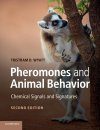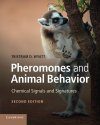– Winner of the 2014 Society of Biology Postgraduate Textbook Award
"Revised and extended since the first edition, this splendid, comprehensive resource covers both 'classic' ideas in the field of chemical communication as well as recent advances [...] The attractive cover [...] hints at some of the delights to be found inside with the content aimed at both the serious researcher and those just wanting a good overview of the discipline. Despite being a serious text, it is very readable and bursting with examples [...] Advice on methodology is given along with suggestions for further reading [...] likely to be useful to anyone starting out in this field [...] Chemistry is helpfully explained in the appendix, so that those with less grounding can follow the ideas [...] All in all, an outstanding textbook and a worthy winner of this year's Society of Biology Book Prize (postgraduate category)."
– Judges, 2014 Society of Biology Book Awards
"'Tristram Wyatt's Pheromones and Animal Behavior takes us on an interdisciplinary voyage along one of the most ancient communication channels. He explores, in depth, how chemical signals and signature mixtures shape social interactions, and why. I enjoyed his writing style, which also makes the book accessible to non-specialists. This excellent second edition is heavily revised and enriched. It unravels some of the mysteries of the world of pheromones, explaining what they are, their origins, functions, evolution, and the communication purposes they serve in a large variety of animals. Wyatt takes us through a well-judged range of examples of some of the amazing chemical communication strategies, from ants right up to the scent of human attraction. The book is far-reaching, inspiring, and brilliantly illustrated."
– Patrizia d'Ettorre, University of Paris 13, Sorbonne Paris Cité
"This thoroughly modern revision of the classic first edition is an amazing journey through the landscape of pheromones. Tristram Wyatt engagingly covers a vast territory, deftly condensing thousands of important academic papers into a lively, informative, and richly illustrated book. Everything from insects to the possibility of sexy secretions from humans is covered from the points of view of neuroethology, chemistry, molecular biology, and more. The book is a must-read for any undergraduate or graduate student or working scientist interested in a singular comprehensive resource on this fascinating topic."
– Leslie B. Vosshall, Rockefeller University, New York
"By highlighting the power of pheromones, this book illustrates how chemical signals rule the animal kingdom. Wyatt challengingly dissects the phenomena derived from chemical communication at molecule, receptor, and neural levels, based on an enormous range of information from past and recent literatures [...] I like his point that the importance of chemistry in understanding pheromone action should be re-emphasized, given the recent trends in science that rely too much on molecular biology and neuroscience techniques. This book can be used as a textbook for students but also for researchers, as [...] Wyatt gives many valuable insights that direct readers into the research. I cannot help thinking that I will cite this book in all research papers that I will publish in the future. The book is too perfect and insightful to imagine that another new edition would publish while I am still alive."
– Kazushige Touhara, University of Tokyo
"Understanding other animals is a matter of seeing the world through their eyes – but awkwardly, for us humans, most animals experience the world primarily through their noses (or equivalent), and to 'see' the world through another organism's nose requires the greatest ingenuity. Remarkably, the fruits of just such enthralling ingenuity is exactly what Tristram Wyatt delivers to us in this rivetingly interesting book, which synthesises cutting-edge research from biochemistry to behavioural ecology, demonstrating en route that what is eye-openingly fascinating can also be life-changingly useful. As Wyatt observes, we live in a chemical world, and this lucidly written and intelligently illustrated book sets the nostrils aquiver as we catch the scent of a new reality."
– David W. Macdonald, Wildlife Conservation Research Unit, University of Oxford
"This is a splendid book that will appeal to a wide audience."
– Malcolm Dando, The Biologist
Reviews of the first edition
"Wyatt demonstrates an impressive grasp of the literature and has written a most enjoyable and informative textbook (one that I read non-stop) [...] The introductory chapter, 'Animals in a chemical world' is the best overview of pheromones that I have ever come across, and worth reading by itself if you have no time or interest to read the entire book [...] It is no exaggeration that, as the teaser of Wyatt's book claims,'[this book] is the first to cover the whole animal kingdom at this level for 25 years'."
– Peter Mombaerts, Nature Neuroscience
"This well-illustrated, thoroughly referenced work is admirably accessible and lucid. It offers much both as a textbook and as an introduction to this remarkable field for new investigators. Tristram Wyatt has given us a gem!"
– John G. Hildebrand, Quarterly Review of Biology
"Pheromones are by far the most important signals used by organisms of all kinds. Wyatt's book is an excellent text and review: up-to-date, comprehensive, balanced, detailed, clearly written, and nicely illustrated."
– Edward O. Wilson, Harvard University
"[...] as an accessible and intelligent general work on pheromones, this book is invaluable. It is also rare and welcome in its capacity for easy and readable explanation of both the proximate and the ultimate roles of pheromones in animal behavior."
– International Journal of Primatology
"It would be hard to overstate the importance of this book for its contribution to the understanding of animal behavior."
– Human Nature Review



































